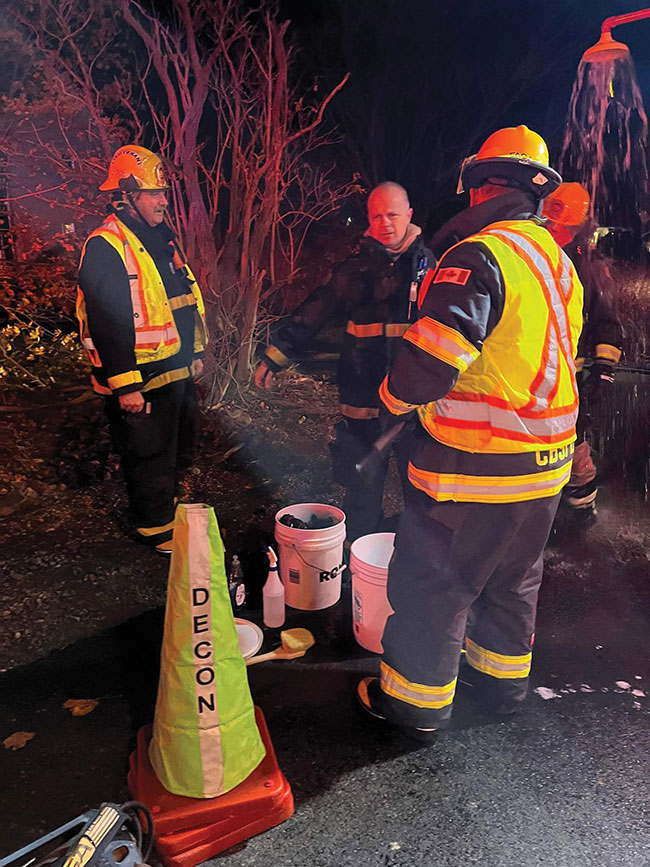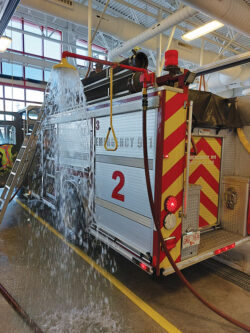
Features
Decon in the fire service
At one time, a dirty, contaminated helmet was considered a trophy. So what changed?
February 24, 2023
By Richard Hynes
 The more we practice and enforce SOG’s, the faster we will adapt to the new normal.
PHOTOS: Richard Hynes
The more we practice and enforce SOG’s, the faster we will adapt to the new normal.
PHOTOS: Richard Hynes In today’s fire service culture, cancer is just as commonly discussed around the kitchen table as our grocery list for the day. We are seeing the effect cancer is having on firefighters globally, as well as in our own departments.
What we’ve learned is that there is undisputable evidence about the link between fire fighting and cancer. In 2021, the Centers for Disease Control (CDC) identified fire fighting as an inherently dangerous occupation, with cancer now becoming the leading cause of death among firefighters.
The need for decon
In recent years, National Institute for Occupational Safety and Health (NIOSH) conducted two large studies focused on firefighter cancer. They concluded that firefighters face a nine per cent increase in cancer diagnoses, and a 14 per cent increase in cancer-related deaths, compared to the general population.

Apparatus mounted decontamination shower are used for on scene decontamination.
Firefighting is proven to be a dangerous job yet, without hesitation, we continue to perform our duties selflessly. While this hasn’t changed, what has is the culture surrounding contaminated PPE.
At one time, a dirty, contaminated helmet was considered a trophy. In the past, we would commonly stand around after a hard battle with fire chatting with our brothers and sisters with whom we haven’t seen in a while. So, what has changed?
Now, that time immediately after fire fighting has been identified as the most crucial for decontamination. The first hour after loss stop is now considered an opportunity to help prevent firefighter cancer. “Shower within the hour” is considered a best practice to reduce exposure to the products of unburned combustion. Does the evidence change our minds individually and will it change the culture of the fire service as we know it? As fire officers, are we disciplining ourselves to automatically activate on scene decontamination?
How do we adopt decon?
It’s crucial for the fire service and our members to educate about safe work practices. Effectively training our members will promote a safety culture that cultivates sound work practices. Sound work practices are designed to reduce exposures to hazardous agents, which will be key to reducing occupational illnesses, including cancer.
Our training should emphasize the proper use and care of PPE and turnout gear. Additionally, training that increases cancer awareness and physical well-being may encourage firefighters to adopt those safer work practices that lower their exposures to these cancer-causing chemicals. The more we practice and enforce SOG’s, the faster we will adapt to the new normal, which includes the use of cancer screening tools.
So, what can your department do in the battle against cancer while under budgetary restraints:
- Unscented wipes for the most vulnerable parts of our body after a fire.
- Garden hose, bucket, brush and soap. These tools will help remove heavy contaminates from PPE and tools. This will help reduce cross contamination during gear doffing and placement into disposable bags for transportation to the firehouse.
- Development of sound SOGs that will be enforced through the chain of command.
- Shower within the hour
These simple, cost-effective initiatives are a start, and will certainly assist in the fight against occupational cancer.
Decon in Conception Bay South Fire Department
So how has the Conception Bay South Fire Department responded to the evidence of occupational cancer in fire fighting over the last two years? Our management team has been proactive in reviewing and addressing the latest statistical evidence on firefighter occupational cancers. This prompted our team to identify areas of improvement, add required resources and training, and implement safe work practices. This has ultimately created a culture shift in our fight against job related illness.
Listed below are some operational changes that have been made.
- Creation of new policy for on scene decontamination, transportation, and laundering of PPE.
- Water proof decontamination bags were purchased for all members for a second set of clean clothing, including gloves and flash hoods.
- Apparatus mounted decontamination shower was purchased for on scene decontamination.
- Our decontamination buckets are equipped with heavy duty industrial bags for soiled gear, decontamination wipes for the neck and face, liquid soap, and large brushes.
- Distribution of new particulate blocking flash hoods for all members.
- Development of a decontamination manual which provides a detailed process of our department’s expectations following firefighting duties.
- New bunker gear has been upgraded to a particulate and petroleum blocking technology.
- A second set of soft goods for fire helmets was purchased for all members of our department.
The evidence is on the table, and now is the time for change. Firefighters today are exposed to more harmful chemicals and carcinogens than ever before. Unfortunately, we cannot eliminate all the hazards of fire fighting, but we can minimize their impact on us. It’s important to focus on areas that can be controlled or managed, such as the decontamination of gear and clean-up of equipment and personnel after the fire is extinguished. This should be at the forefront of every firefighters’ mind while performing their duties.
Richard Hynes has 17 years in the fire service currently holding the rank of fire captain with the Conception Bay South Fire Department. Capt. Hynes also serves as a firefighter with the St John’s Regional Fire Department.
Print this page